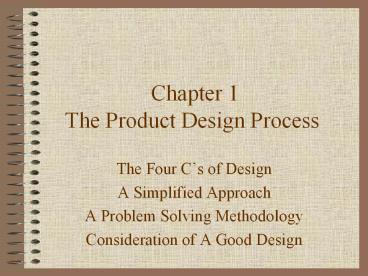Chapter 1 The Product Design Process - PowerPoint PPT Presentation
Title:
Chapter 1 The Product Design Process
Description:
Chapter 1 The Product Design Process The Four C s of Design A Simplified Approach A Problem Solving Methodology Consideration of A Good Design The Four C s of ... – PowerPoint PPT presentation
Number of Views:88
Avg rating:3.0/5.0
Title: Chapter 1 The Product Design Process
1
Chapter 1The Product Design Process
- The Four Cs of Design
- A Simplified Approach
- A Problem Solving Methodology
- Consideration of A Good Design
2
The Four Cs of Design
- Creativity
- Requires creation of something that has not
existed before or not existed in the designers
mind before - Complexity
- Requires decisions on many variables and
parameters - Choice
- Requires making choices between many possible
solutions at all levels, from basic concepts to
smallest detail of shapes - Compromise
- Requires balancing multiple and sometimes
conflicting requirements
3
What is Design?Design establishes and defines
solutions to and pertinent structures for
problems not solved before, or new solutions to
problems which have previously been solved in a
different way
- Difference between Design and Discovery
- Discovery is getting the first sight of something
but design is the product of planning and work - Good design requires both analysis and synthesis
(Analysis is to breakdown complex problems to
manageable parts and synthesis involves the
identification of the design elements that will
compromise the product and the combination of the
part solutions into a total workable system)
4
The Design Process- A Simplified Approach
-
General information
Specific information
Design Operation
Outcome
NO
Evaluation
yes
Feedback loop
Go to the next step
5
Scientific Method vs Design Method
- State of the art
- Existing knowledge
Scientific curiosity
Identification of need
Hypothesis
Acceptance
Conceptualization
Communication
Logical analysis
Feasibility analysis
Production
Proof
Scientific Method
Design Method
6
Consideration of Good Design
- Design Requirements
- Functional performance (F, s, power, deflection)
- Complementary performance (life of design,
robustness, reliability, ease, economy, safety of
maintenance) - Total Life Cycle
- Material selection, productivity, durability
- Regulatory and Social Issues
- ASTM, ASME standards, codes of ethics, EPA
requirements
7
Design Process
- I. Conceptual Design
- II. Embodiment Design
- III. Detail Design
- IV. Planning for Manufacture
- V. Planning for Distribution
- VI. Planning for use
- VII. Planning for Retirement of the Product
8
I. Conceptual Design
- Identification of customer needs
- Problem definition
- Gathering information
- Conceptualization
- Concept selection
- Refinement of product design specification
- Design review
9
II. Embodiment Design
- Product architecture
- Configuration design of parts and components
(feature present like holes, ribs, splines, and
curves are configured). Modeling and simulation
may be performed. The generation of physical
model of the part with rapid prototyping
processes may be appropriate) - Parametric design of parts and components (exact
dimensions and tolerances, materials and
processes, robustness)
10
III. Detail Design
- In this phase the design is brought to the stage
of a complete engineering description of a tested
and producible product.
11
IV. Planning for Manufacture
- Designing specialized tools and fixtures
- Specifying the production plant that will be used
- Planning the work schedules and inventory
controls - Planning the quality assurance systems
- Establishing the standard time and labor costs
for each operation - Establishing the system of information flow
necessary to control the manufacturing operation
12
V. Planning for Distribution
- Shelf life consideration
- System of warehouses for distribution of the
product needs to be designed - Marketing efforts on advertising and news media
techniques must be selected - For technical activities specialized sale
brochures and performance test data must be
generated.
13
VI. Planning for use
- Ease of maintenance, reliability, product safety,
convenience in use (human factors engineering),
aesthetic appeal, economy of operation, and
duration of service are some of the questions to
be answered in a consumer oriented product. - Acquisition of reliable data on failure, service
lives, and consumer complaint and attitudes to
provide a basis for product improvement in the
next design is an important phase VI activity.
14
VII. Planning for Retirement of the Product
- The final step in the design process is the
disposal of the product when it has reached the
end of its useful life. - Useful life may be determined by actual
deterioration and wear or it may be determined
by technological obsolescence. - Industrial ecology considerations dictate a plan
for either disposal of the product in an
environmentally safe way or, better, the
recycling of its materials, or remanufacture or
reuse of product components.































